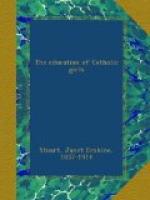In modern times, since the fall of the Western Empire, European history has centred, whether for love or for hatred, round the Church; and it is thus that Catholic education comes to its own in this study, and the Catholic mind is more at home among the phenomena and problems of history than other minds for whom the ages of faith are only vaults of superstition, or periods of mental servitude, or at best, ages of high romance. Without the Church what are the ideals of the Crusades, of the Holy Roman Empire, of the religious spirit of chivalry, or the struggle concerning Investitures, the temporal power of the Popes and their temporal sovereignty, the misery of the “Babylonian Captivity,” the development of the religious orders—in contemporary history—the Italian question during the last fifty years, or the present position of the Church in France? These are incomprehensible phenomena without the Church to give the key to the controversies and meaning to the ideals. Without knowing the Catholic Church from within, it is impossible to conceive of all these things as realities affecting conscience and the purpose and direction of life; their significance is lost if they have to be explained as the mere human struggle for supremacy of persons or classes, mere ecclesiastical disputes, or dreams of imperialism in Church matters. Take away the Church and try to draw up a course of lessons satisfactory to the minds even of girls under eighteen, and at every turn a thoughtful question may be critical, and the explanations in the hands of a non-Catholic teacher scarcely less futile than the efforts of old Kaspar to satisfy “young Peterkin” about the battle of Blenheim.
What about Investitures?
“Now tell us all
about the war,
And what they fought
each other for?”
What about Canossa?
“What they fought
each other for,
I could not well make
out.
But everybody said”
quoth he,
“That ’twas
a famous victory.”
What about Mentana or Castel-Fidardo?
“What good came
of it at last?”
Quoth little Peterkin.
“Why that I cannot
tell,” said he,
“But ’twas
a famous victory.”
The difficulty is tacitly acknowledged by the rare appearance of European history in the curriculum for non-Catholic girls’ schools. But in any school where the studies are set to meet the requirements of examinations, the teaching of history is of necessity dethroned from the place which belongs to it by right. History deserves a position that is central and commanding, a scheme that is impressive when seen as a whole in retrospect, it deserves to be taught from a point of view which has not to be reconsidered in later years, and this is to be found with all the stability possible, and with every facility for later extension in the natural arrangement of all modern history round the history of the Church.




